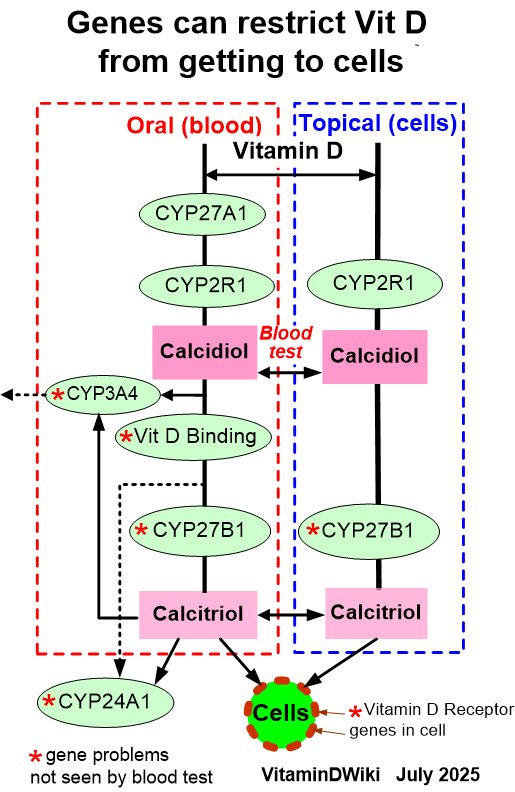Immune system both activates and uses vitamin D (in brain, fight COVID, etc.)
COVID-19 and neurological sequelae: Vitamin D as a possible neuroprotective and/or neuroreparative agent
Life Sciences 297 (2022) 12046 https://doi.org/10.1016/j.lfs.2022.120464
Sebastian García Menendez a,b, Virna Margarita Martín Giménez c, Michael F. Holick d, Francisco J. Barrantes e, Walter Manucha a,b’*
Fig. 2. Schematic representation of paracrine and intracrine function of vitamin D and its metabolites and actions of 1,25-dihydroxyvitamin D on the innate and adaptive immune systems.

1,25(OH)2D = 1,25-dihydroxyvitamin D; 25(OH)D = 25-hydroxyvitamin D; IFN-Y = interferon-Y; IL = interleukin; MHC = membrane histocompatibility complex; TH1 = T helper 1; TH2 = T helper 2; TH17 = T helper 17; Treg = regulatory T cell; TLR2 = toll-like receptor 2; TLR4 = toll-like receptor 4; TNF-a = tumor necrosis factor- a.
a Laboratorio de Farmacología Experimental Básica y Traslacional, Area de Farmacología, Departamento de Patología, Facultad de Ciencias Médicas, Universidad Nacional de Cuyo, Mendoza, Argentina
b Instituto de Medicina y Biología Experimental de Cuyo, Consejo Nacional de Investigación Científica y Tecnologica (IMBECU-CONICET), Mendoza, Argentina
c Instituto de Investigaciones en Ciencias Químicas, Facultad de Ciencias Químicas y Tecnológicas, Universidad Católica de Cuyo, San Juan, Argentina
d Section of Endocrinology, Diabetes, Nutrition and Weight Management, Department of Medicine, Boston University Medical Campus, 715 Albany St #437, Boston, MA 02118, USA
e Laboratorio de Neurobiología Molecular, Instituto de Investigaciones Biomódicas (BIOMED), UCA-CONICET, Buenos Aires, Argentina
SARS-CoV-2, the etiological agent of the current COVID-19 pandemic, belongs to a broad family of coronaviruses that also affect humans. SARS-CoV-2 infection usually leads to bilateral atypical pneumonia with significant impairment of respiratory function. However, the infectious capacity of SARS-CoV-2 is not limited to the respiratory system, but may also affect other vital organs such as the brain. The central nervous system is vulnerable to cell damage via direct invasion or indirect virus-related effects leading to a neuroinflammatory response, processes possibly associated with a decrease in the activity of angiotensin II converting enzyme (ACE2), the canonical cell-surface receptor for SARS-CoV-2. This enzyme regulates neuroprotective and neuroimmunomodulatory functions and can neutralize both inflammation and oxidative stress generated at the cellular level. Furthermore, there is evidence of an association between vitamin D deficiency and predisposition to the development of severe forms of COVID-19, with its possible neurological and neuropsychiatric sequelae: vitamin D has the ability to down-modulate the effects of neuroinflammatory cytokines, among other antiinflammatory/immunomodulatory effects, thus attenuating harmful consequences of COVID-19. This review critically analyzes current evidence supporting the notion that vitamin D may act as a neuroprotective and neuroreparative agent against the neurological sequelae of COVID-19.
📄 Download the PDF from Vitamin D Life
Vitamin D may be the single best way to improve the immune system
COVID test positive is about half as likely if have Vitamin D – 24th meta-analysis - Jan 2022
- Vitamin D improved immune system so much that half did not even test positive
Vitamin D helps both the innate and adaptive immune systems fight COVID-19 – Jan 2022
Only a single supplement taken before infection decreased COVID severity (vitamin D) – Feb 2022
How vitamins A, B, C, D, E, F (Omega), K fight COVID - Feb 2022
Vitamin D Life studies in both categories: Virus and Immunity
This list is automatically updated
{category}
Vitamin D Life - Immunity category
{include}
Many cells can semi-activate, fully activate, and use vitamin D

